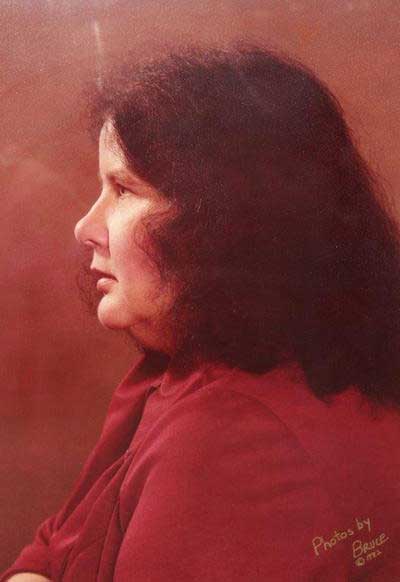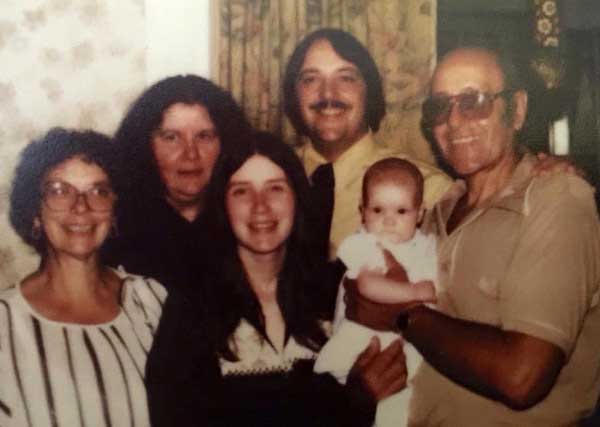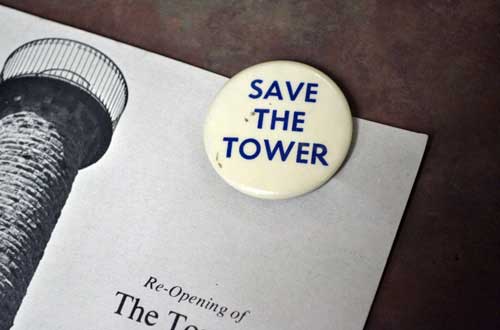Notable Neighbor: Donna Rodden was a trailblazing mayor for Albion
Rodden pushed for historic preservation, removed parking meters in downtown and welcomed international students

This formal portrait by Bruce Landis of Albion’s late mayor Donna Rodden hangs in the village offices. Rodden served as Albion mayor from 1973 to 1984.
ALBION – Several months ago, the Orleans Hub began a series called “Notable Neighbors,” in which people in the community, living or deceased, were profiled. With not much in the news lately but updates on the coronavirus pandemic, I thought perhaps an uplifting story on one of Orleans County’s most accomplished women would be a welcome change.
I feel it is also appropriate to share this story about Donna Rodden, who was mayor of Albion at a time when there were only 13 women holding such a position in the United States, as now, Albion has its second woman serving as mayor, Eileen Banker, and I can’t help but think how proud that would make Donna.
I reached out to Eileen to see if she remembered Donna and realized what big shoes she had to fill.
“I did think of Mayor Rodden, as she had been the only woman mayor of the village,” Eileen said. “I didn’t run on the fact I was a woman. I ran because I felt I could see the positives the village had to offer and I wanted to capitalize on that concept. I believe I was elected, just like Mayor Rodden, not because we are women, but because the voters felt we could do the job.”
I have to credit the pandemic and our mandated stay-at-home orders for my finding this story I had written about Donna, probably 40 or more years ago. Boredom finally caused me to start cleaning out some corners and sorting through boxes and boxes of papers, when in a sewing kit which belonged to my cousin’s late wife, I found six pages I had typed on my Smith-Corona (no relation to the virus) electric typewriter. (Does anybody remember those? I reached out to Donna’s daughters to verify my facts and learned some more interesting things.)
First I learned Donna’s first love was a college sweetheart, who was killed in a horrific accident. They were returning home one night during a torrential rainstorm, each driving their own cars. Donna was following him when he drove onto railroad tracks and his car quit. He was hit by a train, and when she ran to the car, she saw his body smashed into pieces.
I also learned from Donna’s oldest daughter, Roberta Tundermann of Connecticut, that because of the accident Donna refused to drive a car and never did until after her mother died, and she could no longer rely on her mother to chauffeur her around.
Donna’s second love, which Roberta called “the love of her life,” was killed in Germany and she never dated again until years later.
I first met Donna when I was asked to write a story about Albion’s Courthouse Square being named to the National Register of Historic Places. (Courthouse Square is a large block of 38 buildings in the center of town). She was library media specialist at Albion High School at the time, in addition to being mayor of Albion. I do believe the request came from Walter Schutt, who was then police chief in Albion and a supporter of Donna’s, or from her best friend Marie Makowski.
Schutt once commented, “Few people realize what they have here in Albion. Donna has as interesting a past as any public figure, and has done more for the village of Albion than most people can remember.”
Donna served as mayor from 1973 to 1984.
I will never forget the first time I met Donna when I went to the school to interview her. She had long black hair, which hung from a center part. Her clothes were anything but stylish, as she was dressed in a floor-length black skirt, and in spite of it being in the winter, she had on flat slippers with no socks or stockings.
But that was Donna, and being in her presence, you realized you were facing a genius – and a genius doesn’t worry about her appearance. I would learn over the period of several years of knowing her that she was not only a television personality, but a teacher, producer and writer, as well as a mayor. At Syracuse University, she studied speech and communication, got her doctorate in library science and a degree in radio and journalism. She was in the process of studying for the ministry when she died of cancer in June 1985 at the age of 59. Her daughter Chris Capurso of Albion said Donna was so busy doing for others she didn’t take care of herself.
Donna was born in Albion, a daughter of Burroughs and Mildred MacDufy Strickland. She was first in her class all through school and graduated a year early. Burroughs was a judge who had attended Syracuse University, as did Mildred, and wanted Donna to follow in his footsteps, but although she took some law courses, she had other aspirations.
Roberta also attended Syracuse, as well as her son Matt, who is an aeronautical engineer.
Making a mark in the big city
Donna’s career began when she moved to New York City and landed a job packaging radio and television programs. Packaging is the term applied to shooting scenes and collecting shots from movies, and putting them together to form one special show, Roberta explained. The show would then be sold to an advertiser who, in turn, would sell it to a station or network.
Donna had the distinction of being the first woman to produce a television show in New York City, but because she met opposition in getting a job as a woman, much of her work was accomplished under the pen name of Robert Quigley, her first husband and father of Roberta.
Donna had landed a job with Caton Incorporation, and Mr. Caton was a boxing fan. Boxers are said to be superstitious and afraid of elevators. As Donna’s office was on an upper floor of the Empire State Building, the boxers would climb the stairs, rather than take the elevator. One of her most famous shows was Greatest Fights of the Century, which also became the first sports television show to be exported outside the United States. Her other credits include The Big Fight, and World’s Greatest Fighters, as well as animal shows which she put together using much material collected by Walt Disney. All this was before the time of coast-to-coast hookups, when most shows and commercials were live.
“Actors and actresses had to be more accurate then,” Donna told me. “And when radio stars made the transition to television, many had a hard time getting used to having to wear makeup and dress to be seen.”
She recalled one famous radio newscaster who refused to wear makeup or dress for the camera, and he soon faded out of television when he couldn’t accept the challenge.
Early in her years in New York City, Donna worked for a school in New Jersey which helped children with handicaps. There she met Charles Lindbergh, whose son attended there for speech therapy.
Her brother Terry Strickland at the time was stationed at Fort Dix, and was scheduled to go to Korea with the Green Mountain Boys. By the grace of God, Roberta said, Terry developed pneumonia and couldn’t go, so he was later sent to Germany instead. All the men in the Green Mountain Boys were later wiped out.
Donna was interested in all forms of art. She painted, and was an accomplished piano player. At about the same time as her producing career began, she also became interested in directing plays and acting. She appeared on Broadway in All This and Heaven Too, Harvey, Thornton Wilder’s Skin of our Teeth and with Priscilla Gillette in Brigadoon. She directed at the Davenport Theater, and when color television hit the market, two of the first seven shows came from Donna’s office.
I was also made privy to information by Donna (reluctantly) about the time she corroborated with mob bosses to prove the innocence of a man on Death Row and get him released from prison. Roberta said she remembers a time when mafia men came to their door. She said after her mother talked to them, they went away peacefully.
I have to interject at this point how honored I was to have called Donna Rodden a friend. She would occasionally drive out to my house in Millville and bring me a small gift, such as Christmas placemats she had crocheted. And I would be on cloud nine to think that a woman of such acclaim would give me the time of day.
Robert Quigley was the owner of the Lyndonville Enterprise and the Middleport Herald-Tribune, which Donna edited for two years before going back to New York City to resume her work in television. After she and Quigley divorced, Donna married James Rodden, who was a cab driver in New York City and used to pick her up every day. She and James’ daughter is Chris Capurso of Albion.
Donna wrote many songs, a hobby which she pursued, even after returning to Albion. Two of her songs, You are my Angel and St. Mary’s of the Snow, were recorded by Eddie Haywood. A story she wrote on the Erie Canal titled Erie Mouse earned her acclaim and Roberta is hoping to turn it into a book.

This picture of Donna Rodden and her youngest daughter Chris Capurso and family was shared by Capurso’s sister Roberta Tundermann of Connecticut. Rodden is at left rear with Chris’ husband Al Capurso. In front, Al’s parents flank Chris, who is holding infant son Daniel, Donna’s first grandson.
GED teacher, gift shop owner and then a mayor who got things done
After coming back to Albion to live, Donna worked as a teacher at the correctional facility for women and tutored adults for their GED or high school diploma. She also operated a gift shop, The Hole in the Wall, which she sold when she accepted the position at Albion High School. Her introduction to public office came as the result of the death of long-time Albion mayor Bill Monacelli.
“I believe you have to make every office count,” Donna had said at the time. “You have to give the people a choice in order for the democratic system to work. When I understood that no one was going to run for mayor except the man who had been filling the post after Monacelli’s death, I decided to run.”
Donna said, despite the fact women had been given the right to vote 50 years earlier, no woman had ever run for high office in Orleans County. And in spite of the fact she had run for trustee a year earlier and lost by the narrow margin of 23 votes, she ran for mayor to finish Monacelli’s term and won. She was sworn into office on the same Bible her father used.
She said her second term in office came about quite by accident.
“I ran for my first full term to complete the things I started in my first year,” Donna said.
Her opponent this time was a very popular man in Albion and although Donna had won her first election by a large margin, she didn’t expect to win the second time. As a matter of fact, she had ignored the polls showing her popularity and chose to speak at a meeting at the Apple Grove Inn the night of the election. She was at the podium when her daughter Chris burst in and told her the news.
In 1978, her own party refused to endorse her, and both parties nominated the same man.
“As before, the people had no choice, so I ran on the Independent ticket, and won again,” Donna said.
No one could doubt that Donna’s interests were always for the best for Albion. While she admitted that a woman’s emphasis is often on different things than a man’s, she felt that many women would make good mayors or public officials.
In an interesting comparison, Donna paralleled the job of mayor to that of a good housewife.
“A good housewife keeps her house clean and does many things to ease all the members of her family and prepare them for their future,” she said. “So does a mayor try to run all her departments smoothly and cleanly and does many little things to please all her constituents and do what’s best for the future of the townspeople. Likewise, a housewife must balance the budget. You can’t run a home on money that isn’t there, and I feel strongly that deficit spending in government has got to go.”
This is an interesting statement in light of the recent government passing of a trillion-dollar stimulus bill. I can’t but wonder what Donna would have thought about that!
During Donna’s terms in office, she accomplished many of the things she set out to do. Of course, getting Courthouse Square placed on the National Register was a big credit to her. When Mount Albion Cemetery was placed on the National Register, it was only the second cemetery in the nation to be so honored, according to Bill Lattin, who was county historian at the time.
In addition, Donna had a cover placed on the village’s water tower, which had been open since 1932, a situation she felt was a health hazard due. She was responsible for bringing about the construction of a new industrial sewage plant. She got rid of parking meters, which she felt were a penalty to downtown merchants, when shoppers at the plaza could park free of charge. She changed the Albion Police Department to a Public Safety Office and was hopeful in the future that more departments would place more emphasis on public safety and less on police work.
Her motto and aim in life was to “Preserve and protect the past, take care of the people today and prepare for the future.”
‘Donna was all about Albion’
Donna took more than an average interest in the history of Albion and Orleans County. The “Save the Tower” project in Mount Albion Cemetery was completed under her watch, and during her leadership, a sesqui-centennial clock was erected downtown on Main Street for the community’s 150thanniversary. She was founder of the Orleans County Council on the Arts and was responsible for the first donations to the county’s only art gallery.
She also was responsible for a new parking lot being constructed, new sidewalks being put in and trees planted downtown. She brought two new industries to town and worked to establish a youth center in the village. She spearheaded restoration of the lily pond at Mount Albion Cemetery, and after her death, the chapel in Mount Albion was dedicated to her. Bill Lattin attended the dedication, where in the chapel is a quote by theologian Reinhold Niebuhr which Donna lived by.
“Nothing worth doing is completed in our lifetime. Therefore, we are saved by hope.”
Donna instituted a new tax schedule in Albion for new businesses, whereby they didn’t pay any taxes for the first five years, then only paid 10 percent until the end of 10 years.
In discussing some of the problems facing the village, Donna said that Albion was under a handicap for funds to do many of the things she would like to do – primarily replacing the ancient storm sewers in the village after three floods hit the town during her administrations.
“Where 80 percent of the property in most villages is taxable, Albion only has 46 percent of its property on the tax rolls,” Donna said. “The reason for this is because of the large number of historical buildings, churches and school-owned property – all of which are tax-exempt.”
Donna was known beyond Albion for her accomplishments. She made many friends among dignitaries in foreign lands through a program she learned about called “Experiment in International Living,” where foreign students, young adults or public figures visited America and lived in private homes while working, going to school or learning the English language.
This brings to mind a young man I met at her house during her terms as mayor. Donna had mentioned she knew the Shah of Iran and introduced me to a young man from Iran who was living with her at the time. I was given a copy of an Iranian newspaper and speculated at the time that the young man was the son of the Shah, although no one would confirm it. A comment was made he was living with Donna because there was turmoil in his country and he had to go to a safe place.
Roberta shared a story about the time a young man from Egypt was living in the village when an American student was being detained in Egypt. The State Department in Washington contacted Donna and asked if she could intervene to try and get the American home. She did and his family later came from Michigan to thank her.
Under the Experiment in International Living, Donna was responsible for 168 people visiting Albion, representing many religious faiths, 40 countries and every continent.
Many honors came Donna’s way, including an award from Queen Elizabeth and one which previously had only been given to Mother Theresa and Jacquelyn Kennedy. She was named national chairman of “Magazines for Friendship,” a program where Americans, after reading their favorite magazines, re-addressed them and sent them to an English speaking person in a foreign country. At the time I interviewed Donna, more than three million magazines weekly were being sent abroad.
Donna was a firm believer that Americans, as individuals, not the government, were responsible for formulating programs which would determine how other countries felt about us.

Photo by Tom Rivers: In the mid-1970s, Rodden was involved in the “Save The Tower” campaign to make repairs to the Civil War memorial at Mount Albion Cemetery. This photo shows one of the buttons that was used as a fund-raiser.
In addition to being honored by meeting such presidents as Nixon, Eisenhower, Johnson, Ford and Kennedy, Donna also had dinner at the White House several times and rubbed elbows with many notable people. She once co-chaired a women’s symposium with Midge Constanza of Brockport before Midge went to work in Washington. Some of the people Donna met who impressed her the most were Senator Taft, Senator Bingham from New York, Martha Griffiths from Michigan, secretary of state Henry Kissinger and a person she called “a very good friend,” Nelson Rockefeller.
Donna was honored locally, nationally and internationally. She was recipient of a medal from Cambridge University in England; she was named to the International Who’s Who in Community Service for distinguished service to community; she was cited by presidents Nixon, Reagan and Kennedy for “Service as befitting a good American”; and in 1975, she received the National Organization of Women’s Award for “the woman who most changed the world.” She was also the recipient of the American Legion’s Good Citizen Award, the Coast Guard Medal, a commendation from the Girl Scouts of America, a listing in Who’s Who in Finance and Industry, and in 1978, she received the Distinguished Achievement Plaque from the World’s Who’s Who of Women.
Governor Carey, in his first year in office, appointed Donna to his Friendship Committee, whose purpose was to “make New York a more attractive place for visitors.”
Donna was a very modest person, and I only learned of her achievements from other people. Then when I confronted her with the information, she would confirm it.
At one time, while in New York City, she dined with the Duke and Duchess of Windsor, who were visiting there shortly after he abdicated from the throne. They met through a poet Donna knew who was also a friend of Edward.
In addition to Donna’s duties as mayor and school librarian, she was adviser to the Senior Class, director of the Swan Library, director of the Cobblestone Society, director of the Orleans County Historical Monument Association and an executive of the Northwest Frontier Village Officers. She was past president and member of the Business and Professional Women, a matron of the Eastern Star and Rebecca lodges and past president of the Orleans County Art Association.
At the time I knew her, Donna still did some occasional directing, not only at Albion High School, but at places such as Newport, R.I., Pokeno Playhouse in Pennsylvania, Rye Beach in New York and, of course, for Orleans County’s own Theater of Performing Arts.
In spite of all her honors, Donna’s biggest concern was not for her own individual achievements, but for world understanding, which she believed was the basis for world peace.
“Not agreements, or sanctions or appeasement, but by understanding why people do the things they do – then we are on the road to world peace,” she said.
Lattin gave the eulogy at Donna’s funeral, referring to a play she did at Albion Middle School, titled “To Albion with Love.”
“That was the whole essence of what Donna was,” he said. “Donna was all about Albion.”
The world could definitely use more people like Donna Rodden.






































































